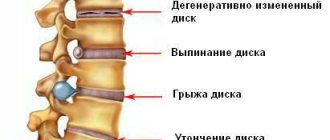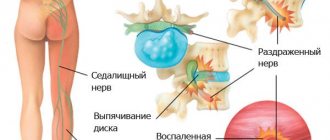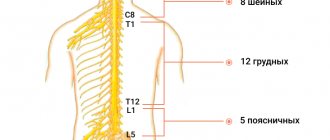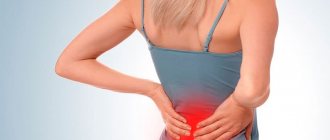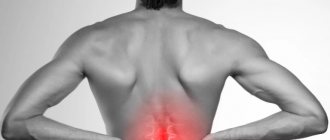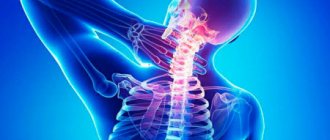Among the complaints of our patients, such an unpleasant symptom as pain in the groin is often encountered. These pains are usually accompanied by discomfort in the lower back, where MRI reveals many hernias or protrusions. However, the pain in the groin is so unpleasant that it drowns out the lumbar symptoms and forces many people to go under the knife of a neurosurgeon to remove a herniated disc. And here comes the moment of truth: the pain in the groin does not go away after the operation, and it is also accompanied by restrictions associated with surgical intervention. This happens because pain in the groin is very rarely caused by an intervertebral hernia, and almost always by changes in other organs. Let's figure out why this happens.
Among lumbar hernias, the vast majority are located (localized) between the 3rd, 4th and 5th lumbar vertebrae, as well as between the fifth lumbar and sacrum. The nerves that are pinched by such hernias go to the legs, so the pain radiates to the hip, knee, calves, and so on. In order for the pain to radiate to the groin, the hernia must be at a higher level - between the 12th thoracic and first lumbar vertebrae. And fortunately, at such a high level, disc herniations are very, very rare, much less common than pain in the groin and lower back. At the same time, certain manifestations of osteochondrosis of the lower lumbar vertebrae occur in almost every patient.
Diseases and pathologies that cause lower back pain to radiate to the groin
If the pain in the lower back radiates strongly to the groin, inflammation or a degenerative process has probably begun in the spinal column or in the internal organs. It is worth familiarizing yourself with the main reasons why pain in the back may appear, radiating to the groin area.
Hard physical work
This is one of the common factors causing discomfort and pain. If you carry a lot of weights at work, you may experience severe pain while moving. However, when physical activity ends, the pain may gradually decrease and then disappear completely.
Injury
The causes of pain in the groin and lower back often lie in back injuries. This pain is different in that it manifests itself at the moment of exertion and is almost unbearable, very sharp. The area around the groin begins to swell, the skin becomes red and swollen. The pain may not go away for up to a day, and the patient is forced to take strong painkillers, and is also often in a forced position, since this somewhat reduces the pain syndrome.
Osteochondrosis
The occurrence of nagging pain in the lower back and groin is not uncommon if you have osteochondrosis in the lower back. This condition manifests itself in that the cartilage tissue becomes less dense, and the cartilage itself becomes thinner and cannot cope with its functions. The reasons may be low mobility, obesity, monotonous loads on the back, etc.
Osteoarthritis of the hip joint
Due to arthrosis, pain in the groin and lower back most often occurs in women over the age of 45. The disease can affect both joints at once or just one. It is not easy to identify a disease; it disguises itself as a lot of others. The first manifestations may be an “ache” near the buttocks, and pain occurs with minimal exertion.
Intervertebral hernia
With a hernia, pain appears when the lower back is loaded. They have an acute “shooting” character, and only after a while the pain syndrome “descends” to the lower abdomen.
Aseptic necrosis of the femoral head
Pain in the groin and lower back often occurs in men 30–50 years old, the pain syndrome is sudden and sharp. The condition is alleviated only by the use of prescription painkillers.
Intestinal pathology
The problem may lie in intestinal pathologies, examples are appendicitis, obstruction, or even oncology. Against the background of lower back pain radiating to the groin, vomiting, bloating and pain in the abdomen, and impaired bowel movements may occur.
Diagnostics
Women, as a rule, turn to a gynecologist. If necessary, a dermatologist, urologist, and surgeon take part in the examination. During the conversation, the circumstances under which the symptom first arose are established, the dynamics of its development, and its connection with various factors are examined. As part of a general examination, local purulent foci and signs of damage to the gastrointestinal tract, urinary tract and musculoskeletal system are identified.
For folliculitis, dermatoscopy is performed. In patients with local infectious processes, purulent discharge is collected. To clarify the diagnosis, the following procedures are prescribed:
- Gynecological examination.
It is carried out to identify inflammatory and non-inflammatory diseases, tumors of the genital organs. The condition of the vulva, vagina, uterus and appendages is examined, signs of emergency conditions are determined, discharge is taken, and sometimes tissue samples are taken for morphological examination. - Ultrasonography.
Ultrasound of the pelvic organs is informative for gynecological pathologies and CPPS. Ultrasound of the abdominal organs is prescribed for damage to the gastrointestinal tract. For patients with suspected urolithiasis and other urinary tract diseases, ultrasound of the kidneys and ureters and ultrasound of the bladder are recommended. - Radiography.
To examine the condition of the uterus and appendages, hysterosalpingoscopy is performed. Women with diseases of the kidneys, ureters and bladder are referred for excretory urography or cystography. For some diseases of the digestive system, irrigoscopy is performed. Patients with injuries and orthopedic diseases are prescribed x-rays of the hip joint. - Endoscopic studies.
Taking into account the presumed localization of pathological changes that provoke pain, women can undergo hysteroscopy, cystoscopy, urethroscopy and colonoscopy. If acute appendicitis is suspected and other diagnostic procedures are insufficiently informative, laparoscopy is performed. - Lab tests.
The list may include general blood and urine tests; PCR tests to exclude STIs; microscopy of urogenital smear; bacterioscopy of discharge from the genital tract and purulent discharge from skin lesions; cytological examination of smears to identify atypical cells; histological analysis of a biopsy of the lymph node, genitals, anus or urinary tract; stool occult blood test.
Groin and lower back pain in men
In some cases, pain is detected in the groin and lower back, the causes of which are related to the functioning of the male reproductive system. There are several types of diseases that can cause pain in the groin and lower back.
Varicocele
It is a fairly common disease that occurs in approximately 15% of the stronger sex. Varicocele appears because the outflow of blood in the veins near the spermatic cord is disrupted. Men complain that the groin hurts and at the same time radiates to the lower back; pain occurs near the scrotum or testicle, most often the left one.
Prostate cancer
Lower back pain most often occurs during a long and chronic course of the disease, when the kidneys or urinary ducts are already affected. The pain has a different character: long aching, shooting or short sharp. At the same time, there is a burning sensation when urinating, stomach pain, erectile function is impaired, and discomfort appears during sexual intercourse.
Spermatic cord cyst
The reason why lower back pain radiates to the groin may be a funicocele, which means the development of a cyst - a cavity in the membrane filled with fluid. In this case, one side of the groin is noticeably painful, and the lesion may affect the left or right cord. Upon examination, the doctor reveals swelling of the scrotum, and the leg may swell on one side.
Causes of lower abdominal pain in women
Pain in the lower abdomen is most common among women. In most cases, it is associated with gynecological problems or special conditions of the female body. Aching pain in the lower abdomen is a symptom that often occurs before and during menstruation. In other cases, it occurs in early pregnancy.
If we consider pathological causes, pain can be caused by tumors, injuries, adhesions and scar changes. The lower abdomen contains the bladder, uterus and ovaries. Therefore, if women have pain in the groin, it is most often associated with the reproductive system. The main reasons include:
- ectopic pregnancy;
- endometritis;
- ovarian cysts;
- cystitis;
- cervicitis;
- colpitis;
- inflammation of the appendages;
- uterine fibroids;
- STI;
- adhesive disease.
Pain in the groin and lower back in women
Treatment for lower back pain that radiates to the groin is often required for women as well. The reasons may be the development or exacerbation of various diseases. It is worth understanding that self-diagnosis is impossible here, and you will need to promptly contact a qualified specialist who will carefully examine your health condition and prescribe medications.
Pelvic inflammatory disease
These include the uterus and ovarian appendages. The pain has no clear localization - the entire lower abdomen hurts, the lower back ache. There may be increased pain due to severe hypothermia, when the temperature rises, malaise and weakness appear. Vaginal discharge that is uncharacteristic of a healthy body often appears.
Exacerbation of chronic cystitis
If pain in the lower back on the right or left radiates to the groin, you have a frequent and painful urge to go to the toilet, and the process itself does not bring relief, going to the toilet is painful, you want to urinate even with an empty bladder, then the problem is probably an exacerbation of cystitis. In this case, the color and smell of urine can change significantly.
Ovarian cyst
Apoplexy of the right ovary is similar to appendicitis, as it is accompanied by nausea, severe pain, vomiting and decreased blood pressure. The situation is the same with the left ovary, only because of the localization of the pain, in this case it is impossible to confuse the cyst with appendicitis.
Trochanteritis
If the lower back hurts on the left or right and radiates to the groin, this may be a symptom of inflammation of the tendons of the thigh, which is otherwise called trochanteritis. This phenomenon is sometimes observed during menopause, when the level of sex hormones in a woman’s blood drops. The pain can radiate not only to the groin, but also to the inside of the thigh.
Hip dysfunction
The hip joint connects the pelvic bones (acetabulum) and the femur bone of the leg. Thanks to him we can walk freely. Dysfunction of the hip joints is, as a rule, inflammatory changes and coxarthrosis of varying severity. Coxarthrosis may be associated with malnutrition of the cartilage of the femoral head as a result of injury, or due to a sedentary lifestyle and certain conditions. Diagnosis of coxarthrosis is based on x-rays of the hip joints, but an experienced osteopath can determine it using special tests.
In the later stages of coxarthrosis, a person practically cannot walk, or has a severe limp and needs hip replacement. The early stages of this disease proceed unnoticed, are characterized by mild pain in the pelvic area and can radiate to the groin. It is good if the patient sees an osteopath at this stage, without waiting for the consequences.
How to relieve pain
It is not always possible to see a doctor right away if your lower back hurts and radiates to the groin. Sometimes you have to look for a temporary solution to relieve pain in the lower body before visiting the clinic. Taking antispasmodics, which include no-spa and papaverine, can help. If you need to bring down the temperature, you can take Ibuprofen or Nurofen, but if the temperature is below 38 degrees, it is not recommended to bring it down. Under no circumstances should you heat or cool a sore spot without a doctor’s instructions. It is also worth providing the patient with bed rest.
Which doctor should I contact?
As has already become clear, there are many reasons why pain appears in the groin and left or right lower back. Determine independently whether in this case it is necessary to be treated by a urologist-andrologist
or
a gynecologist
, a
neurologist
or a surgeon, it is not possible. The best solution in such a situation is to make an appointment with a general practitioner. After the specialist performs an examination, he will draw preliminary conclusions about your state of health and prescribe the necessary types of diagnostics. Based on the results of a more detailed examination, it will become clear which specialist you need to be redirected to, and whether this will be necessary at all. Then you will be prescribed adequate treatment tactics that will allow you to improve your health.
Treatment
Conservative therapy
The therapeutic plan is drawn up taking into account the cause of groin pain. Women can be prescribed:
- Painkillers.
To eliminate pain, analgesics and NSAIDs are used. Medicines may be used strictly as prescribed by a specialist after diagnosis. Failure to follow recommendations can smooth out the symptoms of pathology and make it difficult to identify dangerous conditions. - Antibacterial agents.
For nonspecific infectious processes, broad-spectrum drugs are used; after receiving the culture results, the antibiotic is replaced, taking into account the sensitivity of the microorganisms. For specific infections, drugs are selected that have the most powerful effect on a particular pathogen. - Other medicines.
Depending on the nature of the pathology, treatment can be carried out using diuretics, antispasmodics, etc. In some cases, women are prescribed hormonal therapy. For pain in the groin caused by orthopedic diseases, therapeutic blockades are performed. - Physiotherapy.
UHF, electrophoresis, ultrasound, laser therapy, and magnetic therapy can be effective. When joints and ligaments are affected, the regimen includes massage and physical therapy.
Radiation therapy or chemotherapy is indicated for patients with cancer pathologies. For local purulent processes, dressings are performed.
Surgery
Women with pain in the groin area undergo the following operations:
- Local infections, lymphadenitis:
opening, drainage of boils, abscesses; opening of purulent lymphadenitis and adenophlegmon. - Hernias:
laparotomic and laparoscopic hernioplasty for inguinal and femoral hernias using own tissue or mesh grafts. - Gynecological pathologies:
opening of an abscess and removal of the Bartholin gland, excision of foci of endometriosis, laparoscopic tubotomy or tubectomy for ectopic pregnancy, removal of cysts, fibroids and benign tumors, amputation of the uterus, hysterectomy or panhysterectomy for malignant neoplasia. - Urological diseases:
various options for lithotripsy for stones, ureterolithotomy, pyelolithotomy, ureteral stenting, partial and radical nephrectomy, TUR of the bladder, cystectomy. - Gastrointestinal diseases:
open or laparoscopic appendectomy, elimination of intestinal obstruction, dissection of adhesions or bowel resection for intestinal obstruction. - Orthopedic pathologies and injuries:
operations for ARS syndrome, endoprosthetics, open osteosynthesis of the femoral neck.


